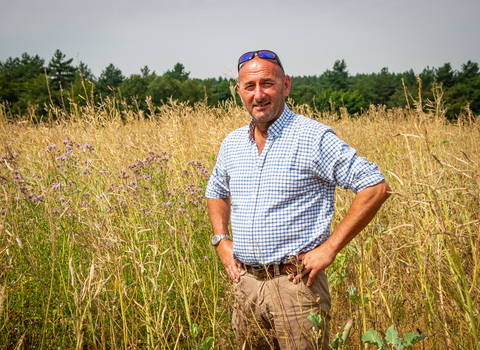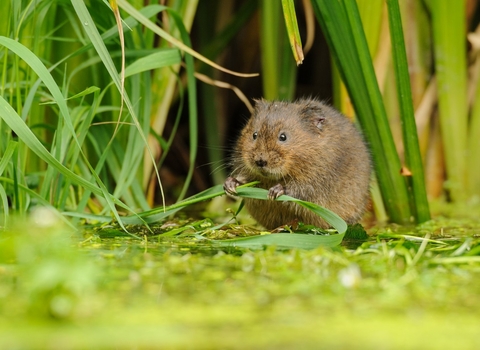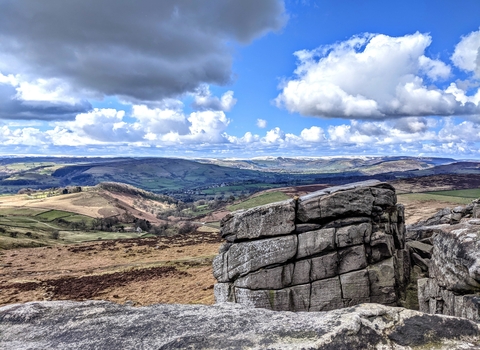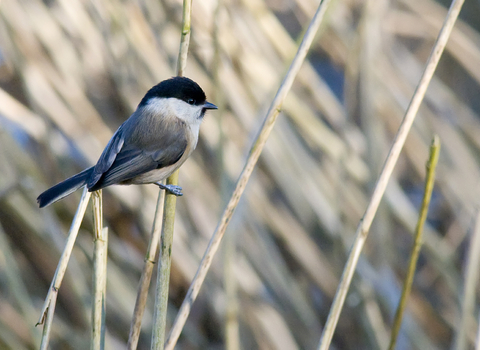How to get involved
There are many different and exciting ways to get involved with the Wild Peak Project including pledging your land, time or money, through a donation…
We are currently building a live pledging map for our webpage that will allow you to make your pledge and pin your location on our Wild Peak map. Until then, if you’d like to make a pledge or discuss getting involved please use our enquiry form below or email wildpeak@derbyshirewt.co.uk directly.
Pledge your Land -
Do you have land that you can pledge towards our Nature Recovery Network?
We are already working with range of fantastic land owners, community groups and Councils across the region, who we are helping to support and advise on their rewilding journeys. If you would like to pledge your land or enquire about rewilding community or publicly owned land near you, please complete our enquiry form below.
Pledge your time -
Do you have time to support an existing rewilding initiative or join your local biodiversity action group?
If you need help finding a local group or project, please get in touch using the form below, and we will do our best to connect you with some of the amazing people we are already working with!
Pledge a donation -
As well as land and volunteer time Wild Peak also needs funding to deliver our work. Every penny donated means we can give more advice, plant more trees, create more meadows and reintroduce more species. So if you are short of time please make a difference by donating whatever you can to Wild Peak.
If you would like to discuss a corporate or large project donations with us, please get in touch by emailing wildpeak@derbyshirewt.co.uk directly or filling in the form below.
Donate now and be a part of the solution
Wild Peak Case Studies
Land Owner – Cat Raynor, Thornhill
“I love spending time in nature and watching wildlife and photographing it has become a bit of a passion. Having got a few fields I had never realised that I could leave them to return to a more wild habitat and had let various local farmers use it for grazing so I was really excited after talking to Derbyshire Wildlife Trust to find they were promoting an initiative to get more of Derbyshire wild again. The project has only just begun but I am really hoping to increase the biodiversity over all areas and hopefully go a small way to benefit nature.” – Cat Raynor, Thornhill
We are currently working with Cat who owns an area of land close to our Thornhill Reserve. We have just completed the baseline habitat surveys for the site and over the next few months will be working closely with Cat to produce a land management and monitoring plan.
Community Group – Whaley Bridge Biodiversity Group
“Biodiversity Whaley is an interesting mix of nature lovers, ecologists, artists, professionals, younger parents and retirees, but we all have one thing in common: a passion for nature conservation, with re-wilding at its very heart. Our aims are to support our community in: taking practical action to nurture biodiversity in our area; to protect and strengthen local species and habitats and to raise awareness of the importance of biodiversity.
Our first project, which started in 2019, initially looked at creating wildflower verges. As a result, we started working collaboratively with High Peak Borough Council (HPBC) and identified some areas for ‘re-wilding’. We are now very happy to report that the first of these areas ‘The Linear Parkway’ is in its first year! We prepared a management plan for HPBC and as a result, the mowing regime has now been reduced from 16 to 2 cuts a year after plants have set seed.
Going forwards, we will survey this site regularly for plant and butterfly species and monitor our re-wilding efforts for years to come. We are also looking to expand our re-wilding efforts across Whaley and we have a number of other similar projects with HPBC at the planning stages, one of which will draw inspiration from a large local re-wilding scheme which will be showing at the RHS show at Tatton Park this year. Most importantly, through these re-wilding efforts and our other key projects (e.g. wildlife sightings database, Whaley Hogwatch, invasive species mapping) we are establishing a network of key community contacts, many of whom are also landowners interested in ‘re-wilding’. Our aspiration is to create a ‘Wild Whaley’ and we are excited to be working with the Wild Peak Project.” - Zoe Connolly, Acclimatise Whaley
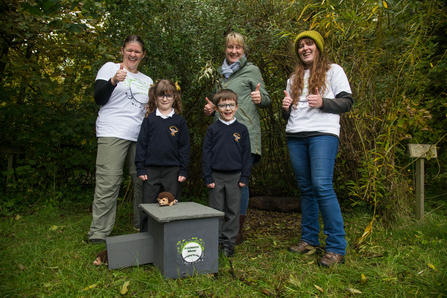
Donor – Porter Pizza, Sheffield
“We opened Porter Pizza in July 2015. As well as focussing on making the best possible Neapolitan pizza, we've always been conscious of our environmental impact. That said we still get through a lot of meat and cheese and we burn (well-seasoned) wood so we were keen to explore ways to mitigate our carbon footprint. I've been a closet environmentalist for years, donating to Trees for Life, reading books, going on demos, doing outdoor sports and generally worrying about the state of the natural world. When our sales increased during the pandemic it felt time to start doing more as a business. My brother put us on to Rewilding Britain, who in turn pointed us to the Wild Peak project. After a chat with Dave and Phoebe from the project we felt inspired to get behind it, making a monthly donation to match what we spend on firewood. We're excited to see areas of the Peak District become richer places for nature and am convinced that the Wild Peak team have the expertise and motivation to make things happen. More and more businesses are looking for ways to get involved in the fight against climate change and ecosystem collapse and we wanted to be a part of it.” – Dave Musgrove, Porter Pizza
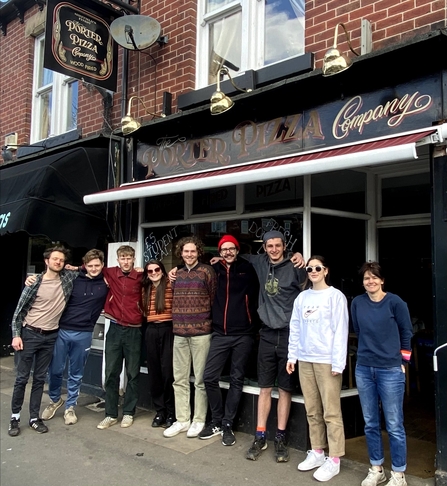
(C) Porter PIzza
Land Owner - Sunart Fields
Sunart Fields is a 120 acre uplands farm based in the High Peak, Derbyshire. It was coal mined up to 100 years ago and until recently it was an active dairy farm. The evidence of that recent treatment, including slurrying, fertilizing and cattle poaching the ground is highlighted by the proliferation of docks in many of the fields, as the sward has been allowed to grow. There are also some already nicely wilded areas on steeper sections where tractor access was difficult, including large sections of scrub and naturally regenerated tree saplings. The land is now at the start of its rewilding journey and is working to restore a healthy balance with nature.
Livestock continue to be present on site in very low numbers and include occasional cattle, pigs and low numbers of wild red deer. This is combined with human intervention to mimic natural processes and encourage a mosaic of habitats. Human intervention is needed, such as tree and hedge planting, to restore the seed bank and give nature a jump start.
The project has engaged with the local community, many of which have given their time to help remove fencing, plant trees and hedgerows, conduct surveys and join in with rewilding on connected parcels of land and gardens.
NATURE BASED ENTERPRISE
The project has developed forest school facilities providing an opportunity for children to immerse themselves in a wilder landscape. The area includes tree strung canopies, log seating around a fire circle and will soon also include nature viewing hides. This has already been enjoyed by a range of specialist groups including Girl Guides, Brownies, Rainbows, Being Outdoors (forest school) and The Sea Within creative mindfulness. Dry stone walling courses are also held, teaching a range of audiences this traditional skillset. A range of events including outdoor talks and walks from experts on related subjects take place regularly.
The rewilding project also produces natural foliage supplied direct to local florists and added to weddings, bouquets and Christmas Decorations. This year participation at RHS Tatton to showcase the beauty of native plants growing on the land earned them a Gold medal and Best in Category, provoking much interest from individuals and the press. The project also sells a range of wild meat from the small number of animals who graze the area.
KICK-STARTING REWILDING
Whilst natural regeneration and vegetation recovery is encouraged, it would take a long time without assistance. Native tree planting and hedgerow planting has therefore been undertaken with help from volunteers – last season 9,000 plants were planted. This aims to restore the native seed source for natural regeneration in the future.
Low numbers of pigs have also been introduced to the site to increase disturbance and re-start habitat succession. They are allowed to graze extensively and create patches of bare ground and rootled earth, into which harvested seeds are scattered. Cattle are also present on site from time to time and in low numbers creating a mosaic of vegetation.

